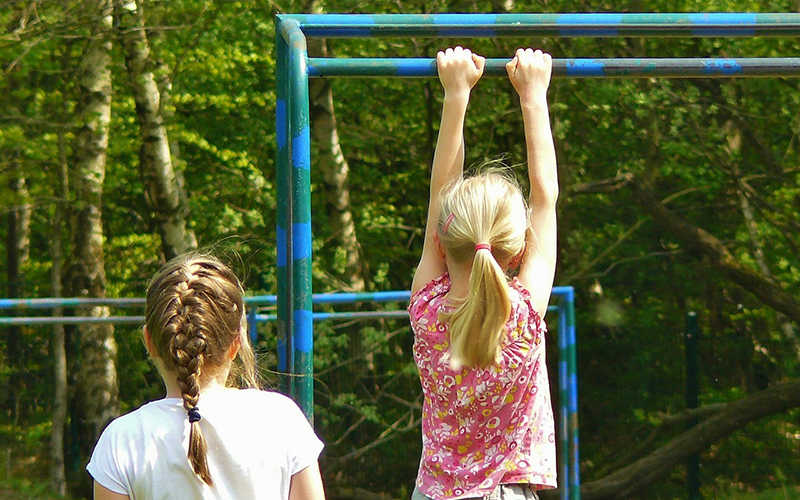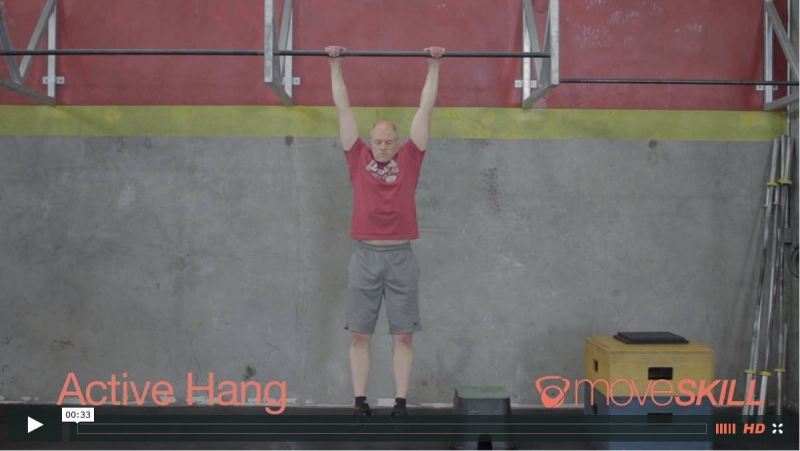Natural Movement Workouts: Hang Time

The Journal of Clinical Psychology reported jungle gym pastimes are a thing of the past, and gone are the days when swinging from the monkey bars is a safe activity on the playground.1 But is the related danger really something adults and children should be overly concerned about? Exercise today neglects to include many functional movement patterns, like hanging or brachiating (swinging from rung to rung on an overhead ladder or bar).2 “Hanging and the much more challenging action of swinging from object to object, uses upper body strength in a general sense. Swinging requires the full participation of every bit of tissue from the fingers to the lower body,”3 said Katy Bowman, a biomechanics specialist on natural movement and development.
Although our physical exercise capabilities have not changed from our Paleolithic ancestors, we have mechanically engineered the functional movements of climbing and carrying very heavy loads out of our modern life.4 Our bodies are paying the price. Increased rates of osteoporosis, osteopenia, and sarcopenia,5, 11 in addition to common shoulder and back problems can be attributed to muscle and joint weakness or imbalance. In 2006, approximately 7.5 million people were treated for shoulder injuries,6 and the National Institute of Arthritis and Musculoskeletal and Skin Diseases estimates 8 out of 10 people will experience back pain in their lives.7 So, how might we incorporate hanging and brachiating into their exercise regime?
Our bodies were genetically designed for these kinds of movements. Paleoanthropologists suspect bipedalism in humans was directly correlated to swinging and suspensory climbing, rather than for walking.9 Just look at all babies today. The palmer grasp reflex that enables them to grab a finger is the very same mechanism our hunter-gatherer ancestors used to grab a branch.8, 10 In fact, babies are even strong enough during their first six months of life to be able to suspend their entire body when gripping a bar.12 The grasping reflex begins to disappear at 6 months of age, however research suggests it is only the lack of cultivation of the capability that reduces its appearance.8 For this reason alone, we should encourage our children to hang on their arms, and join in on the fun.
Where to get started?
Begin to add isometric hangs and brachiation movements to your fitness routine a few times a week, working up to daily sessions of up to 7 minutes.13 You can install a pull-up bar in your home for convenience or visit your local playground.
Passive hang
Begin by holding onto an overhead bar with your hands about shoulder-width apart, and your arms completely straight. In this passive position, your shoulders are relaxed and up close to your ears. Ideally, you are able to support your full body weight.
However, if you are a beginner or rehabilitating a shoulder injury take some of the weight off of your arms by placing your feet on the ground, either by using a low bar at playground or placing your feet up on a bench. In the supported position, your hands, wrists, elbows, shoulders and hips will be in alignment, and your knees and feet will form a 90° angle.
Active hang
From the passive position above, retract your shoulder blades back and down towards the ground. Return to the passive position and repeat for your desired amount of time.

Brachiation Basics
Once you have built enough endurance to successfully perform passive and active hangs, experiment with brachiation. Test your strength to see if you can perform passive or active hangs on one arm at a time before adding in the momentum. Try swinging from side-to-side, using each arm as you move across an overhead ladder, like monkey bars at a playground. As you become more skilled, the options for where you can go with your arms are unlimited.
References
1. Schwebel, D. Safety on the playground: Mechanisms through which adult supervision might prevent child playground injury. Journal of Clinical Psychology in Medical Settings 2006:135-143.
2. Available at: //www.nhlbi.nih.gov/health/health-topics/topics/phys/types.html. Accessed October 7, 2014.
3. Available at: //breakingmuscle.com/family-kids/katy-bowman-and-biomechanics-human-growth-necessity-monkey-business Accessed October 7, 2014.
4. Gordon AM, Forssberg H. (1997) Development of neural mechanisms underlying grasping in children. In: Connolly KJ, Forssberg H, editors. Neurophysiology and Neuropsychology of Motor Development. Clinics in Developmental Medicine No.143/144, London: Mac Keith Press. p 214–31.
5. O’Keefe J H, Vogel R, Lavie CJ, Cordain L. Exercise like a hunter-gatherer: a prescription for organic physical fitness. Progress in cardiovascular diseases 53.6.2011: 471-479.
6. Available at: //orthoinfo.aaos.org/topic.cfm?topic=a00327. Accessed October 7, 2014.
7. Medline Plus. Back Pain. //www.nlm.nih.gov/medlineplus/backpain.html. . Accessed October 7, 2014.
8. Crompton, RH, Vereecke EE, Thorpe SKS. Locomotion and posture from the common hominoid ancestor to fully modern hominins, with special reference to the last common panin/hominin ancestor. Journal of Anatomy 212.4 2008: 501-543.
9. Jones, D., Hoelscher, D. M., Kelder, S. H., Hergenroeder, A., & Sharma, S. V. (2008). International Journal of Behavioral Nutrition and Physical Activity. International Journal of Behavioral Nutrition and Physical Activity, 5, 42.
10. Hadders-Algra M. The Neuronal Group Selection Theory: a framework to explain variation in normal motor development. Developmental Medicine & Child Neurology, 2000: 42: 566–572.
11. Cotter M, Loomis D, Simpson S, Latimer B, Hernandez C. Human Evolution and Osteoporosis-Related Spinal Fractures. PLoS ONE 6(10): e26658. doi: 10.1371/journal.pone.0026658.
12. Pennock E. From Gibbons to Gymnasts: A Look at the Biomechanics and Neurophysiology of Brachiation in Gibbons and its Human Rediscovery. 2013. Student Works. Paper 2.
13. Available at: //www.idoportal.com/blog/hanging. Accessed October 7,2014.
Stephanie Vuolo
Stephanie Vuolo is a Certified Nutritional Therapist, an American College of Sports Medicine Personal Trainer, and a Certified CrossFit Level 1 Coach, and mother.
More About The Author




